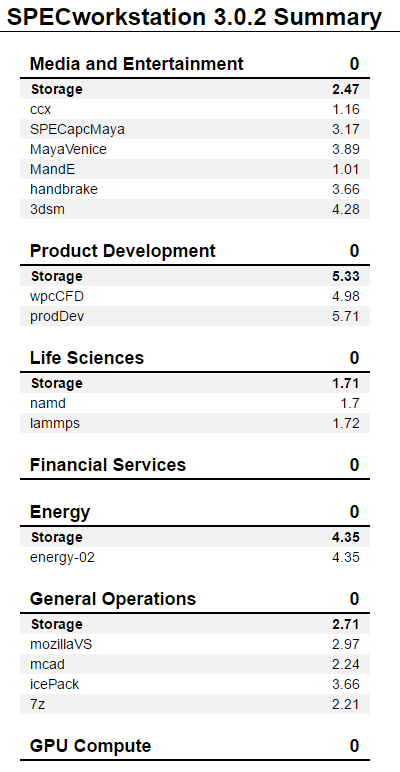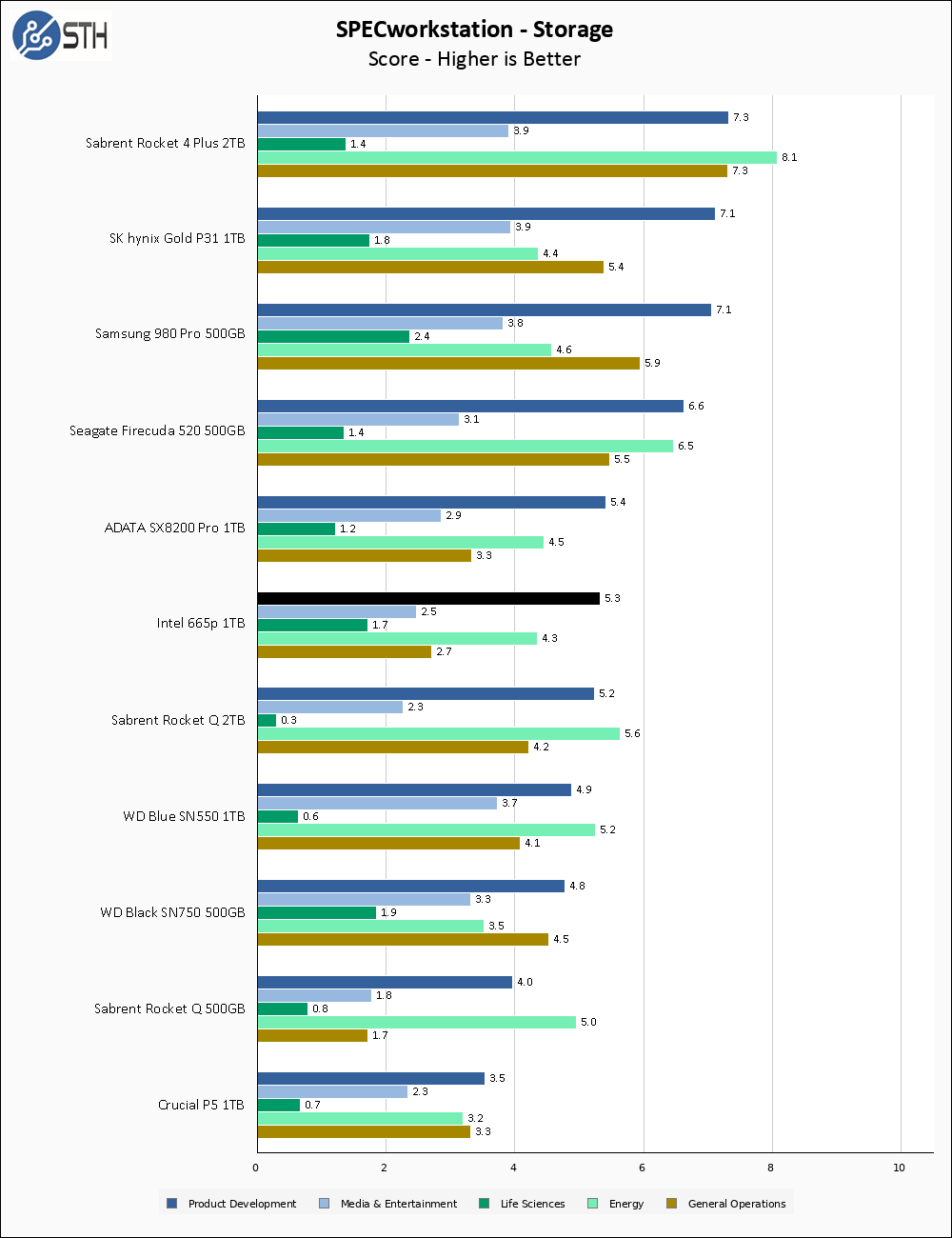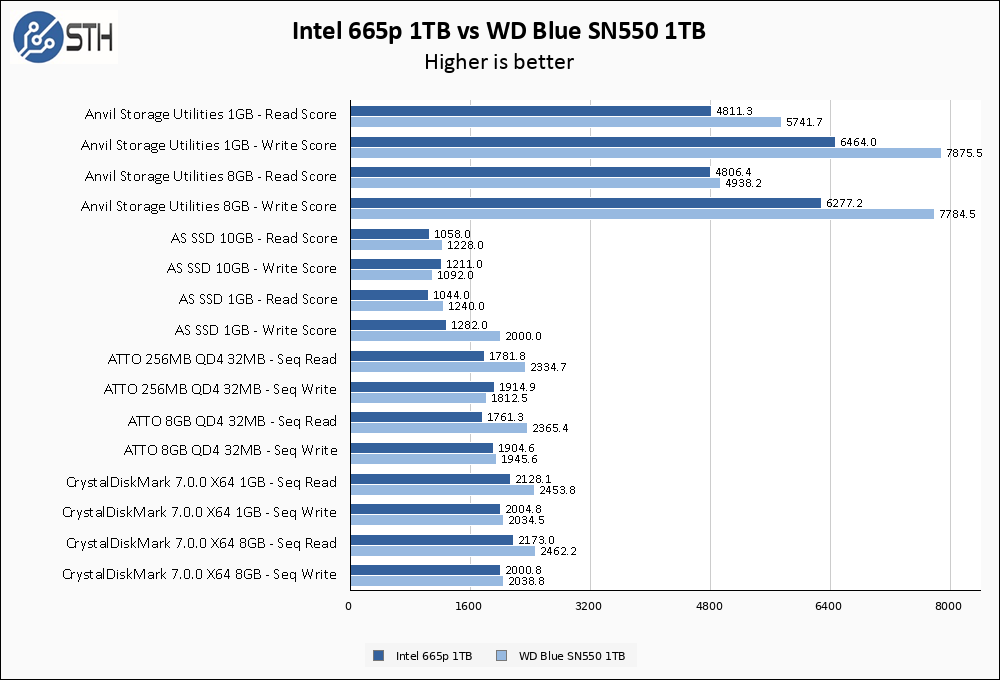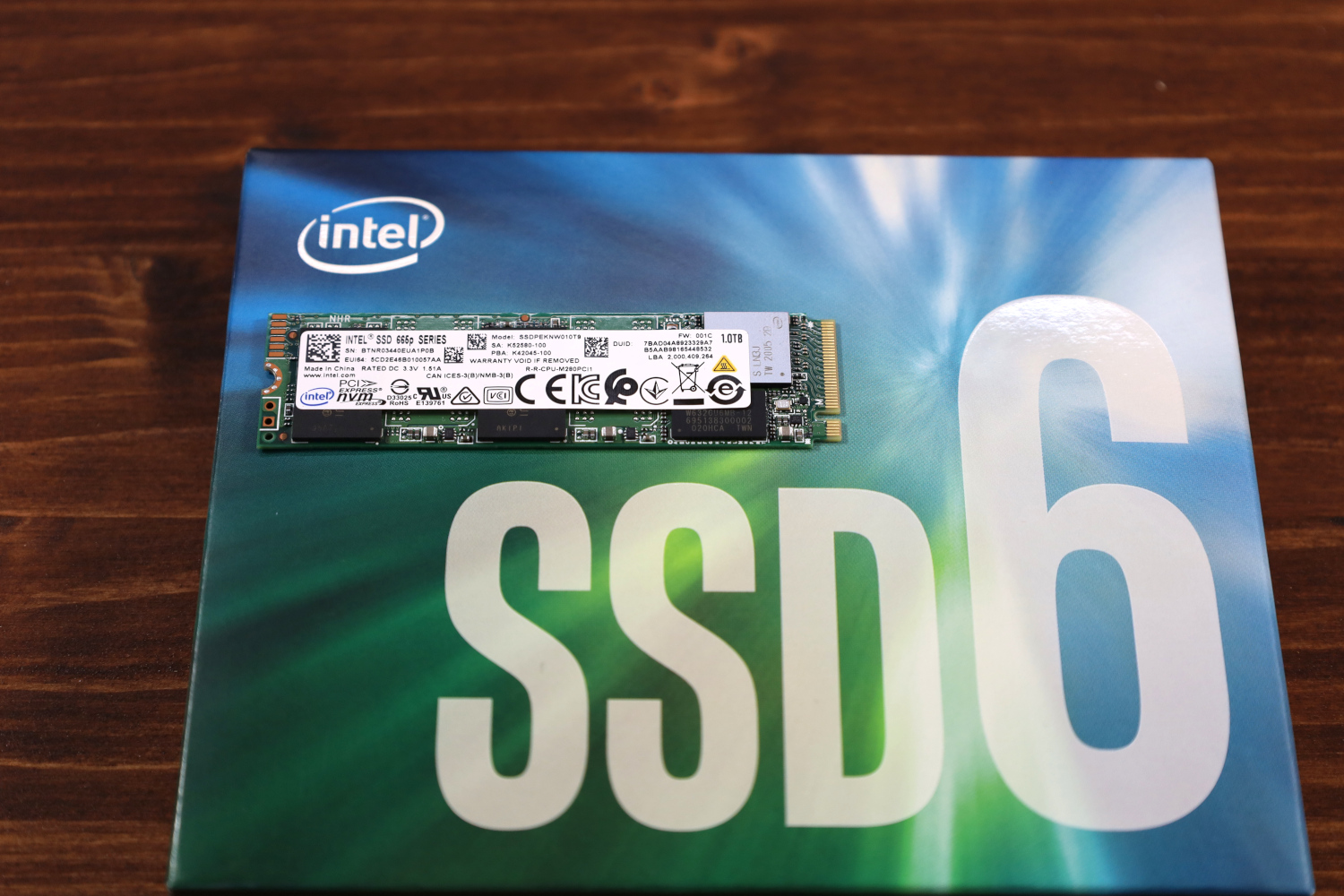SPECworkstation 3.0.2 Storage Benchmark
SPECworstation benchmark is an excellent benchmark to test systems using workstation type workloads. In this test, we only ran the Storage component, which is fifteen separate tests.


The Intel 665p 1TB is a strong performer in SPECworkstation. Strong is relative though and finishing middle of the pack is about the best this drive has managed across our test suite.
Intel 665p 1TB vs WD Blue SN550 1TB
There are a few drives that the Intel 665p 1TB manages to more-or-less compete with, but the WD Blue SN550 1TB has the most similar rated performance specs.

For the most part, performance between these two drives is relatively similar. The WD Blue SN550 wins more often than it loses, though, and when it wins it does so by larger margins than the rare Intel 665p victory. Overall WD’s DRAMless SN550 coupled with TLC seems to outpace the Intel 665p, which matches QLC with a DRAM cache.
Temperatures
We monitored the idle and maximum temperature during testing with HWMonitor to get some idea of the thermal performance and requirements of the drive. Please keep in mind that our test bench is an open frame chassis in a 22C room, and is thus not representative of a cramped low-airflow case.

The Intel 665p does fine in terms of temperatures, peaking at 60C during our testing.
Final Words
I want to like the Intel 665p 1TB SSD. It satisfies an essential requirement in a product for me, in that it lives up to its own performance claims. Available for approximately $95, the 665p is among the least expensive 1TB PCIe 3.0 SSDs available, which is always a positive selling point as well. This is an under $0.10/GB NVMe SSD.
On the other hand, the reason the 665p is able to meet its performance claims is that they are so modest to begin with. Essentially everything about the drive is conservative: performance, endurance, and pricing. The extremely consistent performance is a strong positive in the drive’s favor, but unfortunately, that consistency repeatedly placed the drive near the bottom of our testing. The performance was at least always above anything achievable by a SATA drive, which at least justifies the small price premium held by the drive over some even less expensive SATA options.

The Intel 665p 1TB is a decent drive, but it certainly is not particularly exciting. With that said, it gets the job done and does so at a minimum cost. For that, I view it as a competent entry-level drive for a buyer just moving into the PCIe 3.0 SSD space. For STH readers, it is also a solid low-cost option to upgrade PCs for friends, family, and co-workers as well as low-cost and decent capacity boot/ primary drives.




great detailed review! it looks like 665p is already approaching end of life.
670p is on the way.
Yes. We want to look at the 670p, but having the 665p in our benchmark database would be useful when that time comes, so we went ahead and looked at it as well!
No mention of power consumption?
Power consumption active is .1 Watt
Idle is .04 watt it’s a nvme what more do yt want.
I’m a fan, both of the drives in my build are 665ps.
Endurance isn’t high, sure, but that’s planned obsolescence. It only needs to survive until the model as a whole becomes obsolete.
For CrystalDiskInfo drive attributes screenshots, would you be willing to change the view to decimal from hex? Function > Advanced Features > Raw Values > 10 DEC
Quoting: “This drive comes equipped with 2x 512GB packages, for a total of 1024GB of NAND. With 1000GB accessible to users, this leaves 24GB reserved by the controller.”
This is confusing. I’m pretty sure the two NAND packages would 512 GiB (binary: 512 x 2^30 bytes) not 512 GB (decimal: would be 512 x 10^9 bytes), for a total of 1024 GiB = 1 TiB (2^40 bytes). As far as I know (not an expert), this is how NAND goes.
Now, if the usable capacity is actually 1000 GB = 1 TB (decimal: 10^12 bytes) which seems plausible, that would ~99 GB (= 2^40 – 10^12) reserved by the controller, not 24GB.
Even if the usable capacity was 1000 GiB (neither 1 TiB nor 1TB), that would be ~26 GB (= 2^40 – 1000 x 2^30), still not 24 GB (and neither 24 GiB, yet close).
To be fair, even Intel’s product brief is unclear about this and is mixing both binary and decimal units, while using decimal prefixes for both. The advertised capacity, for example, is (I’m quoting) “1024 GB (1 TB)”. I’m lost.
Bottom line is: let’s try to use the right prefixes and things will get easier. This isn’t just nitpicking: at the terabyte or tebibyte scale, this is starting to make a difference and understanding overprovisionning is key to appreciate SSD endurance (and pricing).
G, the official and actual capacity is 1024GB (not GiB). 1TB+2.4% bonus.